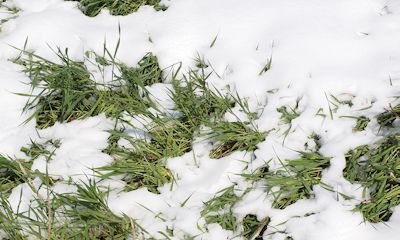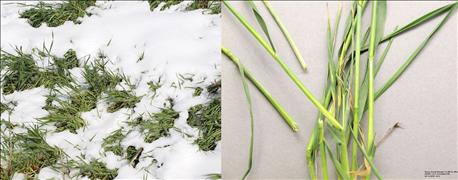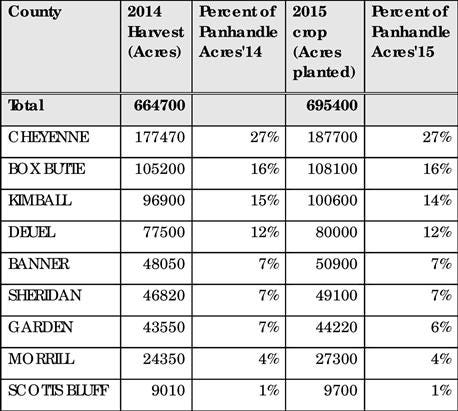May 14, 2015

The May 9-10 spring storm might have caused damage to a significant portion of the winter wheat acres in the Panhandle, according to initial observations by Nebraska Extension personnel.
However, producers need to scout their fields closely for damage. And it is still too early to calculate potential yield losses.
The storm brought a lot of moisture. There were reports of 3 to 5 inches of precipitation, some of it in the form of a heavy wet snow with wind, followed by several nights of sub-freezing temperatures in the mid- to upper 20s.

Left: A Banner County winter wheat field is covered by snow, causing some lodging. Right: Closer inspection shows damage to the stems of individual wheat plants.
Where the winter wheat was covered by snow, freeze damage may be minimal, but some lodging was observed when the snow cover came off. Where the wheat was exposed, freezing temperatures may have caused some damage. This will depend on the length of time the wheat was exposed to these temperatures and the growth stage of the plant.
Damage probably cannot be determined until at least a week or more after the storm ended.
When the storm hit, the growth stage of most Panhandle winter wheat ranged from pre-boot to head emergence. Low temperatures the morning of May 11 ranged from 26 to 28 degrees Fahrenheit. In the boot stage, a temperature of 28 degrees for more than two hours can result in moderate to severe damage.
Even if heads emerge, the extent of damage cannot be estimated until flowering. The effects won’t be known until the young kernels begin to develop and fill. In areas where the wheat was not as far along, such as the northern Panhandle, there may have been less damage.
The best information on winter wheat freeze damage can be found in Nebraska Extension circular EC132, Freeze Injury to Nebraska Wheat.
~~~PAGE_BREAK_HERE~~~

This table shows winter wheat acreage in the Panhandle, by county, for 2014 and 2015.
Careful field inspection and sampling are necessary to estimate the degree of damage. Wheat viewed from the road on May 12 near Scottsbluff appeared to have recovered. But on closer inspection, many stems were broken or crimped. From 10% to 40% of the stems were broken or crimped which will affect both grain yield and quality.
Wheat can compensate for lost leaves or stems since remaining tillers that produce viable heads will produce somewhat more grain, but it will not compensate for lost stems if loss is above 25 to 30%.
Growers who already had sub-par stands caused by winter kill are encouraged to evaluate yield potential to see if taking the wheat to harvest is the best choice.
Much of the Panhandle’s wheat acreage could have potential damage. In the panhandle crop reporting district there are over 695,000 acres of wheat this year (see table). Since all of this area had heavy, wet snow, the impact could be significant.
Options after determining damage
Wheat producers with significant damage have several choices. The first and least expensive is to leave the growing crop and take it to harvest. Depending on crop insurance coverage, this may not make money but it may keep a producer from losing money.
The grain yield will probably be low with poor quality. The projected price on crop insurance for wheat is $6.41 per bushel, so producers with revenue coverage may have an attractive revenue guarantee, compared to expected actual revenue from both lower yields and lower prices.
A second option is to take the crop for forage, either as harvested hay or for grazing. If grazing is done, bloat prevention blocks or similar supplements containing magnesium and calcium should be placed in the field for the livestock.
~~~PAGE_BREAK_HERE~~~
Growers need to review their herbicide program to make sure there would be no harvest or grazing restrictions. Also check crop insurance provisions for fallow eligibility if wheat is grazed or used for hay.
A third option is to terminate the wheat with Roundup, then plant back to an alternative crop such as proso millet, corn, or sunflower. Tillage is not recommended due to soil moisture loss.
Because spring precipitation has been above normal over most of the Panhandle, stored soil moisture in growing wheat is excellent. Growers need to review their herbicide program to make sure there would be no plant-back restrictions for the crop they are considering. Again, check crop insurance provisions for fallow eligibility if another crop is planted
Due to current timing, either millet or sunflower could be selected depending on sub-soil moisture at the specific farm and farmers’ budget. Corn is an option, but current prices may be a detriment. Sorghum is an option; however yield results in past research plots at Sidney have shown variable yields because of maturity and iron chlorosis problems.
The UNL Crop Production budgets can be found on http://farm.unl.edu/crops/budgets .
Those choosing to terminate their damaged wheat should consult with their insurance agents about the implications of terminating the crop.
Click here to read a related article on the recent snowstorm in the Panhandle.
Source: University of Nebraska Panhandle Research and Extension Center
You May Also Like




